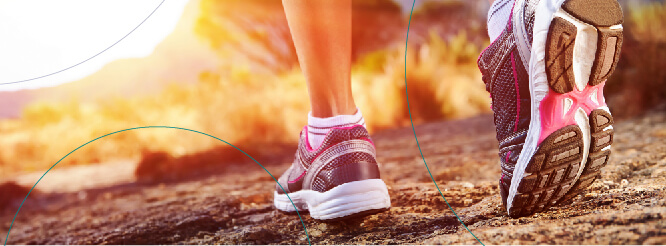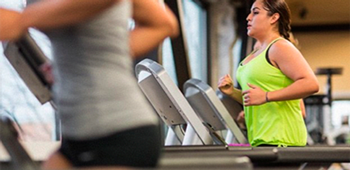
Walking is one of the most simple and accessible ways to engage in physical activity. It is usually regarded as an activity that most people can do, and that can be done anywhere, both indoors and outdoors; it also comes at a very low risk, there’s no need of any special equipment, and it comes at little to no cost. Walking regularly and at a medium intensity pace can deliver great health benefits that impact multiple parts of the body. It can either prevent certain diseases, enrich or complement the treatment of some of them, and it can even contribute to weight loss. These are all reasons why walking is regarded as one of the most convenient, practical and valuable physical activities that can equate or even surpass the health benefits of exercise.
Although it seems very simple, walking is a very complex activity in terms of body mobility. Walking involves major muscle groups in our body: the large muscles of the lower body, which do most of the work, but also the muscles of our arms and upper body, specially our trunk. All these major muscle groups coordinate and contract together when we walk. More than half of our body’s muscle mass intervenes and engages in this activity [1], which sets a chain reaction of positive effects throughout our whole body. For instance, the effort we make for walking increases the demand for oxygen in muscle cells, our heart then starts pumping more blood to fulfill this demand, so our heart rate slightly increases, improving our circulation, endurance, even our metabolism. So, walking sets the pace for many simultaneous physiological changes that result in multiple health benefits.
In what follows, we will talk about the many health benefits that walking can provide and which are the conditions in which we can obtain the most out of our walks.
Energy expenditure while walking
Walking is a great activity that expends energy, no matter the pace and duration. However, the best health benefits can be obtained when we adopt a medium intensity pace for our walks. This is not to say that slow-pace walking accomplishes no benefits at all, just that medium-pace is usually more rewarding.
Walking, faster than customary, and regularly in sufficient quantity into the ‘training zone’ of over 70% of maximal heart rate, develops and sustains physical fitness: the cardiovascular capacity and endurance (stamina) for bodily work and movement in everyday life that also provides reserves for meeting exceptional demands [2].
The rate of energy expenditure in a physical activity can be measured in METs, kilocalories, joules or oxygen consumption. The Metabolic Equivalent of Task (MET), for instance, is the rate at which we expend energy, per kilogram of body mass, compared to the energy we spend when we are seated quietly. 1 MET equals to the amount of energy we spend when we are seated, quietly and resting, which usually uptakes 3.5 milliliters of oxygen per body mass kilogram per minute.
According to the 2018 Physical Activity Guidelines Advisory Committee Scientific Report, walking slowly or strolling requires about 2.0 METs, walking at about 3 miles per hour requires 3.3 METs, and running at 5 miles per hour requires about 8.3 METs [3].
According to this Committee, a physical activity can be regarded as “sedentary” when it requires 1.5 METs or less. In this sense, walking at a slow-pace, meaning equal or less to 2 miles per hour, is regarded as a light-intensity activity, right next to cooking activities or standing while grocery shopping. Walking at a medium pace or briskly (between 3 and 4 miles per hour), on the other hand, is a moderate-intensity activity, similar to mopping, vacuuming or raking a yard. Walking at 4.5 to 5 miles per hour and, of course, running is considered vigorous intensity activity [3].
Of course, the energy expenditure accomplished while walking depends on many different factors. This is what makes walking such a highly flexible and adaptable activity. The walking pace can be adjusted to either lower or higher, but also, the effort put into each pace can be higher or lower, depending on the steepness or smoothness of the road to walk. The variables of distance or time walking also affect into how much energy is invested in this activity.
Recommendations for walking
Walking is a highly recommended activity for every age group.
According to the World Health Organization’s guidelines and recommendations, adults aged 18 to 64 years should do at least 150 to 300 minutes of moderate-intensity activity, such as riding a bike, dancing, hiking, rollerblading or brisk walking, per week. Another alternative is to do 75 to 150 minutes of vigorous-intensity activity, such as running, swimming, skipping, aerobics or any sport, per week.
Children and adolescents aged 5 to 17 years should do an average of 60 minutes per day of moderate-to-vigorous intensity activity [4]. The same applies for very young children, younger than 5.
Walking is one of the easiest and most convenient ways to practice exercise and burn calories. 30 minutes to 1-hour walks, either daily or 3 days per week, at a medium to fast pace, is a great way to start an easy and healthy fitness routine.
Walking is also way to kickstart a more active lifestyle among the elderly or people that lead a more sedentary life.
Walking is ideal as a gentle start-up for the sedentary, including the inactive, immobile elderly, bringing a bonus of independence and social well-being. As general policy, a gradual progression is indicated from slow, to regular pace and on to 30 minutes or more of brisk (i.e. 6.4 km/h) walking on most days [2]
It has been proven that walking, even at a slow pace, has good health benefits, specially in the elderly. A study involving 189 people with an average age of 66.8 years old concluded that low-intensity walking, meaning less than 100 steps per minute, improves physical function, mental health and quality of life [5].
For individuals who perform no or little moderate-to-vigorous physical activity, replacing sedentary behavior with light-intensity physical activity reduces the risk of all-cause mortality, cardiovascular disease incidence and mortality, and the incidence of type 2 diabetes [3].
Health benefits of walking
Everybody can benefit from walking, regardless of age. Walking is great for children, adolescents, adults, the elderly, even pregnant women. In this sense, walking can deliver different types of benefits for every type of population.
Benefits among children 3 to 6 years of age
- It improves bone health and weight status [3]
Benefits among children and adolescents 6 to 17 years of age
- It improves cognitive function in many of the following:
- Executive function
- Attention
- Academic performance
- Memory
- Crystalized intelligence
- Processing speed
- It improves cardiorespiratory and muscular fitness
- It improves bone health
- It improves cardiovascular risk factor status
- It improves weight status and decreases adiposity
- It lowers and ameliorates symptoms of depression
- It reduces risks of dementia [3]
Benefits among adults of all ages
- Walking reduces the risks of mortality associated to any type of disease, as a consequence of its positive impact in cardiovascular fitness. The improvement of cardiovascular fitness accomplished by walking is likely to translate into a 15% reduction in mortality risk [1].
- It greatly benefits cardiovascular fitness and aerobic capacity. A meta-analysis of 18 studies showed that moderate-intensity walking increases aerobic fitness by 10% [1]. This can be explained in the structural adaptations that walking motivates in the body, such as an increased capacity of the heart and altered control of vascular resistance to blood flow [1].
- It benefits blood pressure, reducing hypertension and the risks of having a heart disease or a stroke. For instance, a study showed a reduction in resting systolic and diastolic blood pressure when individuals with slightly elevated blood pressure (prehypertension) undertook four 10-minute walks distributed over the course of the day. This reduction lasted 10-11 hours after the final walk [6].
- It improves metabolism and reduces blood lipids [1].
- It also improves insulin sensitivity, which benefits glucose control and reduces the risks of type 2 diabetes. A systematic review showed that regular walking (2.5 hours a week of brisk walking) was associated with a 30% lower risk of developing type 2 diabetes [7].
- It improves body composition and weight status. Walking has a positive effect on body mass index (BMI) and body fat. It reduces the risk of gaining excessive weight and it helps in the effort of losing weight.
- It lowers the incidence of certain cancers, such as bladder, breast, colon, endometrium, esophagus, kidney, stomach, and lung cancers [3].
- Walking has a great impact on mental wellness. Walk sessions trigger a “feel-good” effect, it boosts self-esteem, it keeps you in a positive mood [1], and it even promotes your creativity.
- It favors mental health. Walking reduces the risks of depression and at the same time reduces any of its symptoms. It also reduces anxiety and its disorders.
- It benefits sleep and improves sleep outcomes, even among people suffering from insomnia or sleep apnea.
- It improves general quality of life… as an obvious consequence of all the benefits that have been described above.
Benefits among older adults
- It reduces the incidence of falls and of fall-related injuries, as it maintains coordination and general mobility.
- It also improves general physical function
Benefits among pregnant or post-partum women
- It reduces the risk of excessive weight gain
- It reduces the risk of developing gestational diabetes
- It comes at no risk to the fetus and mother if practiced at a moderate-intensity level.
- It also reduces the incidence of post-partum depression [3]
Risks of walking
The benefits of walking sure sound wonderful… but are there any associated risks? People have pointed out the possible dangers of walking, specially in our densely populated cities in which traffic accidents and air pollution are the norm more than the exception. For instance, it is true that distracted walkers or runners that exercise with their headphones on are at a higher risk of getting into accidents. It is also true that the air quality in some cities is far from ideal. However, the danger of sedentary behavior is way higher than the low incidence dangers of walking.
When it comes to walking, the benefits seem to outweigh it risks. In this sense, walkers and runners should take proper measures to avoid any of the associated risks,
- making sure that they don’t walk using headphones,
- that they walk on proper terrain and roads meant for runners or outdoor exercise,
- that they use proper running shoes,
- that they check weather conditions and air quality in their preferred weather app before heading the road,
- that they keep properly hydrated,
- and that they listen to their bodies in case they need to take a break or take care of their posture and movement.
How to start and maintain routine walks
If you would like to start your own walking routine, here are a few recommendations:
- Set an ideal time, one that is most convenient for you and that it doesn’t interfere with your sleep, rest or regular activities.
- Set an ideal place, one that it’s both inviting and of easy access to you.
- Pick comfortable clothes and shoes. The more comfortable you are, the more likely you’ll want to take long strolls.
- Pick a highly motivated and compromised partner or join a group of walkers in your community. There is such as thing as positive peer pressure when it comes to exercise.
- Mix in intensive sprints every so often in your walk. You can get the best out of your walks by adding a few minutes of extra intensity to your pace.
- Track your steps. Using a pedometer to count your steps or using a GPS to track your miles can be a great strategy to keep a track of your progress and a record of your accomplished goals.
- Recognize and celebrate your progress. Be proud of what you accomplish to keep yourself motivated and going for more.
- Stick to your goal and persevere! Set your mind for success, you can do this, even if it is a few steps at a time. Just keep going.
Contact us
If you’re interested in knowing more about the benefits of walking or if you are looking for healthy ways to lose weight, call our clinic today. At LIMARP International Center of Excellence for obesity, we offer integral bariatric programs that treat obesity from a multidisciplinary approach. Our treatments rely on either surgical or nonsurgical interventions, nutritional guidance, psychological counselling and fitness. Call our clinic or send us a message to schedule a free consultation today.
References
[1] P. Kelly, M. Murphy, and N. Mutrie, “The Health Benefits of Walking,” in Transport and Sustainability, vol. 9, C. Mulley, K. Gebel, and D. Ding, Eds. Emerald Publishing Limited, 2017, pp. 61–79. doi: 10.1108/S2044-994120170000009004.
[2] J. N. Morris and A. E. Hardman, “Walking to Health,” Sports Med., vol. 23, no. 5, pp. 306–332, May 1997, doi: 10.2165/00007256-199723050-00004.
[3] Physical Activity Guidelines Advisory Committee, “2018 Physical Activity Guidelines Advisory Committee Scientific Report,” U.S. Department of Health and Human Services, Washington, D. C., 2018. [Online]. Available: https://health.gov/sites/default/files/2019-09/PAG_Advisory_Committee_Report.pdf
[4] “Physical activity,” World Health Organization, Nov. 26, 2020. https://www.who.int/news-room/fact-sheets/detail/physical-activity (accessed Sep. 30, 2021).
[5] V. R. Varma et al., “Low-Intensity Walking Activity Is Associated With Better Health,” J. Appl. Gerontol., vol. 33, no. 7, pp. 870–887, Oct. 2014, doi: 10.1177/0733464813512896.
[6] S. Park, L. Rink, and J. Wallace, “Accumulation of physical activity: blood pressure reduction between 10-min walking sessions,” J. Hum. Hypertens., vol. 22, no. 7, pp. 475–482, Jul. 2008, doi: 10.1038/jhh.2008.29.
[7] C. Y. Jeon, R. P. Lokken, F. B. Hu, and R. M. van Dam, “Physical activity of moderate intensity and risk of type 2 diabetes: a systematic review,” Diabetes Care, vol. 30, no. 3, pp. 744–752, Mar. 2007, doi: 10.2337/dc06-1842.


